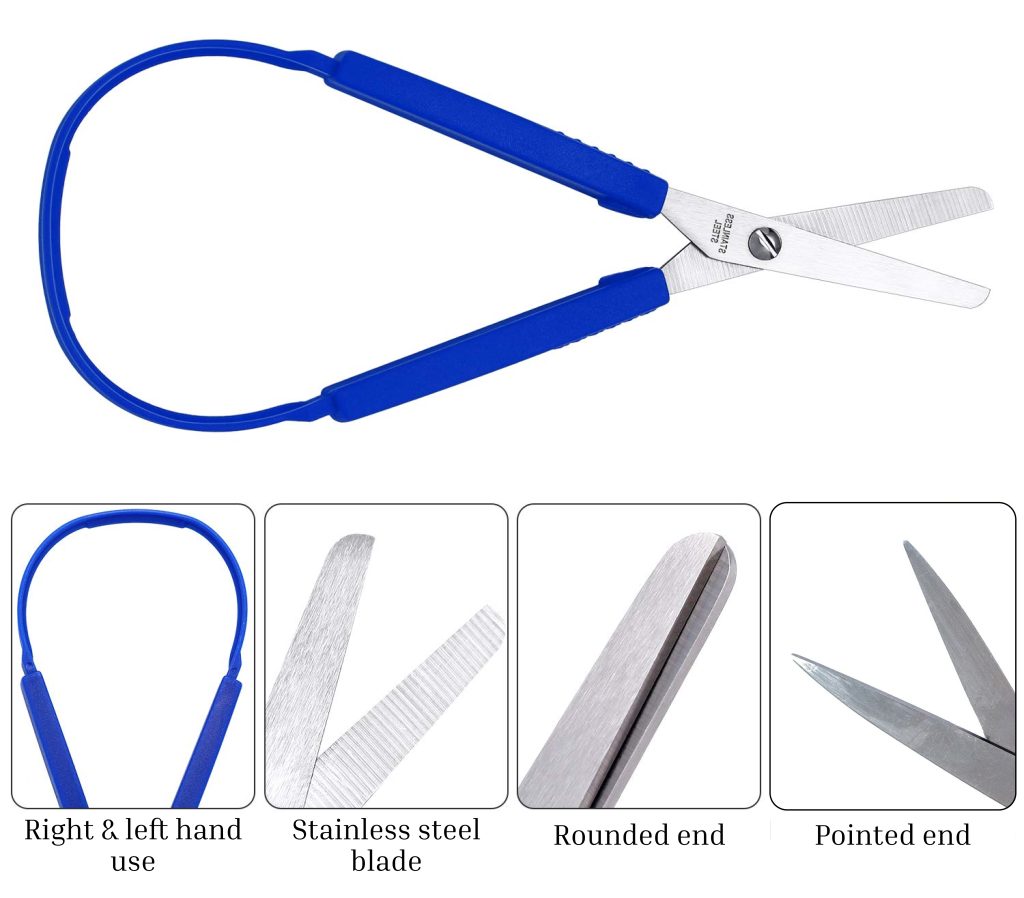Adaptive scissors are specialized cutting tools designed to assist individuals with physical disabilities or limited hand strength, dexterity, or coordination. For people with conditions such as cerebral palsy, arthritis, or hand tremors, these scissors can be particularly beneficial in achieving greater independence and ease in everyday tasks.
Key features
1. Continuous Loop Handles
The most distinctive feature of loop scissors is the continuous loop handle, replacing traditional dual finger holes. This design allows users to operate the scissors with their whole hand rather than individual fingers. These handles provide better control, making it easier to grip for individuals with limited hand mobility or those who struggle with precise finger movements. The oversized loop handle exemplifies the social model of disability by acknowledging that standard scissors create barriers for individuals with limited hand dexterity or strength. By modifying the tool rather than expecting the person to adapt, loop scissors remove societal obstacles to participation in cutting activities. The flexible loops accommodate a diverse physical abilities rather than enforcing a one-size-fits-all approach.
2. Spring-Loaded Mechanism
Loop scissors are equipped with a spring mechanism that automatically reopens the blades after each cut. This feature reduces the physical effort and fatigue required while simplifying the cutting process for people who have difficulty with the repetitive open-close motion required by traditional scissors. From the perspective of the medical model, adaptive loop scissors are designed as a compensatory tool to address an individual’s physical impairment. People who experience difficulty using traditional scissors, such as those with cerebral palsy or arthritis, are viewed as having a medical condition that the scissors can help to “correct.” The spring-loaded mechanism compensates for muscle weakness, and the large handles provide a solution to limited fine motor control. This feature also reflects the economic model by enhancing productivity. People with disabilities can complete cutting tasks more efficiently, potentially improving their economic participation in school, work, or independent living contexts.
3. Lightweight Design
Adaptive loop scissors’ lightweight design ensure that people with limited hand strength or fatigue can use them without straining. This feature makes them suitable for prolonged use, such as in school settings or arts and crafts activities. The cultural model of disability provides another perspective. The evolution of scissor design to include ergonomic features reflects a cultural shift towards valuing comfort and usability for all users, regardless of ability. Moreover, the relatively affordable price point of many adaptive loop scissors models, often ranging from $10 to $30, makes them accessible to a wider range of individuals, further embodying the principles of inclusive design by ensuring that financial constraints don’t become an additional barrier to accessing this helpful tool.

Adaptive loop scissors further exemplify inclusive design through their safety options and versatility. Available with round or pointed tips to cater to different safety needs and cutting precision requirements, both styles feature the same contoured handles for comfort. Their ambidextrous design allows use in either hand, benefiting left-handed individuals and children still developing hand dominance. This flexibility aligns with the social model of disability, creating a tool that adapts to diverse user needs rather than expecting users to conform to a standard design.
In conclusion, adaptive loop scissors offer more than just a functional tool—they reflect the importance of inclusive design in promoting independence, dignity, and participation for people with disabilities. By incorporating these design principles, these tools enable people with cerebral palsy, arthritis, or any condition affecting hand function to participate more fully in activities that require cutting. This boosts their independence and confidence, allowing them to participate more fully in school, work, or leisure activities.
